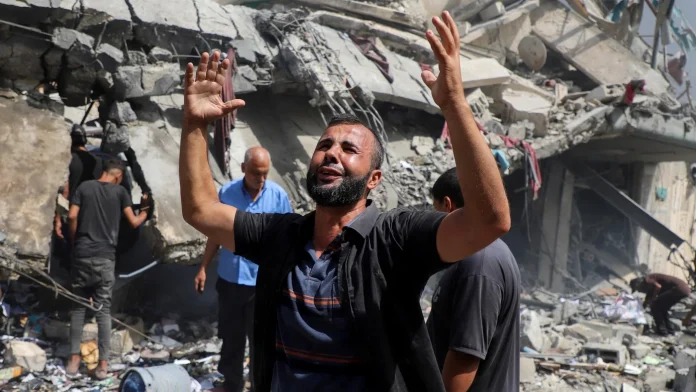Last month, Israel declared it was going to fully occupy Gaza City and intended to force all Palestinians there and elsewhere in the north – around 1.2 million people altogether – towards the south. Relentless Israeli attacks since 11 August have forced half of the city’s population out, leaving around half a million remaining as paratroopers backed by tanks push a ground offensive into various neighbourhoods, reported the Middle East Eye.
Meanwhile, booby-trapped robots and explosive-packed, remote-controlled vehicles have been used to level the city.
“Every day, the Israeli occupation detonates dozens of explosive-laden vehicles in neighbourhoods that are only around 10 minutes away from where I stay. And I feel them approaching day after day, but where would I go?” said Dima Abuaita, who lives in the central Gaza City neighbourhood of Rimal.
“I have already left my home in the Tal al-Hawa neighbourhood and took only a few of my belongings with me. I couldn’t carry more, and it was the harshest situation anyone could go through because you have to choose between what you need to survive and what you want to keep as a memory with you.”
While many Palestinians like Abuaita have not fled Gaza City due to the exorbitant costs and lack of transportation, others refuse to leave their homes, believing they would not be allowed to return.
Hala Rohme, originally a resident of Sheikh Radwan neighbourhood north of Gaza City, says she will be moving from one place to another within her hometown but never to the south.
Most residents of the city and northern Gaza were forced out in the genocide’s earliest months, but returned during a ceasefire earlier this year.
Now, Israeli officials seem intent on fully depopulating the area and erasing all Palestinian life there.
The experience of the 1948 Nakba, when 750,000 Palestinians were permanently forced from their homes during the creation of Israel, means many believe there will be no way back for them if they leave now.
Besides, Rohme notes, when Israel is bombing tents in so-called Israeli-designated “safe zones” or cars of displaced people fleeing Gaza City, “it is not worth it to move from one deadly place to another”.
“I left my home around a week ago under devastating bombardment. We felt that the ceiling was going to fall on us. So we came to my in-laws’ home in the Old City,” said Rohme, who has never left the city during the war.
“We don’t want to leave because we know that if we did, we would never be able to return.”
In late August, Israeli Defence Minister Israel Katz warned that Gaza City “will become Rafah and Beit Hanoun” if Hamas doesn’t surrender, referring to two Gazan towns that have been almost completely destroyed by the Israeli military.
While Israeli tanks have advanced into the northern and eastern parts of the city, the remaining central and western areas remain under intense bombardment, including air strikes, artillery shelling and heavy gunfire.
In one incident, a relative of Rohme was killed after an Israeli explosive-laden vehicle detonated in a nearby neighbourhood.
“My cousin’s husband from the Haddad family remained in his home in Tal al-Hawa after my cousin fled with her children to another area. There were no tanks, and the booby-trapped vehicles had not reached his area yet, and he never thought the explosions’ effect would reach him,” Rohme said.
“A few days ago, the house collapsed on his head after an explosive-laden vehicle was detonated nearby. He was killed.”
Last week, Israeli news outlet Walla reported that the military had stationed an “unprecedented” number of explosive-laden, remote-controlled vehicles to be detonated in urban areas in Gaza City.
The remotely detonated vehicles are originally aged armoured personnel carriers (APCs), converted into “mega-explosives” instead of being scrapped. The practice is referred to by the Israeli military as “suicide APCs”.
“These robots are the nightmare of this war. They have the capacity to destroy entire neighbourhoods at once, and the shrapnel has reached us multiple times, even though we are relatively far from the explosions. This is a policy of leave or be killed,” Rohme said.
On Sunday, Israeli army spokesperson Avichay Adraee said in a post on X that the 36th Division began entering Gaza City as part of “Operation Gideon’s Chariots II”, as the offensive has been dubbed, following two weeks of preparations and strikes.
It follows “Operation Gideon’s Chariots I”, which was launched in May and involved extensive land, air and sea operations that captured 65 percent of the Gaza Strip by early August.
However, key objectives, including the complete defeat of Hamas, the release of captives, and the relocation of civilians to the south, were not achieved.




